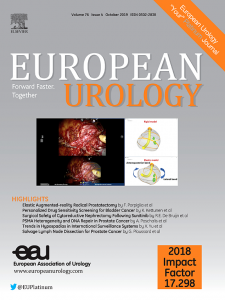First-in-human Study of a Dual-modality Prostate-specific Membrane Antigen–targeted Probe for Preoperative Positron Emission Tomography/Computed Tomography Imaging and Intraoperative Fluorescence Imaging in Prostate Cancer
IF 25.3
1区 医学
Q1 UROLOGY & NEPHROLOGY
引用次数: 0
Abstract
Background and objective
Accurately distinguishing between cancerous and noncancerous tissues during robot-assisted radical prostatectomy (RARP) is a challenge that can increase the risk of residual disease. This study aimed to evaluate the safety, optimal dose and accuracy of a dual-modality prostate-specific membrane antigen (PSMA)-targeted probe (68Ga-P3) for preoperative positron emission tomography (PET)/computed tomography (CT) imaging and intraoperative fluorescence imaging in prostate cancer.
Methods and surgical procedure
Each participant received an intravenous chemical dose of 68Ga-P3 (10, 20, and 40 μg/kg), with radioactivity of 3.7 MBq/kg. PET/CT imaging was conducted 30, 60, and 120 min after injection to evaluate its biodistribution and dosimetry. RARP was performed at 24 ± 6 h after injection, in the sensitive mode of Firefly fluorescence imaging.
Key findings and limitations
Between May 2024 and July 2024, a total of 16 patients were included; 68Ga-P3 was well tolerated without any adverse events related to 68Ga-P3 administration or fluorescence imaging. At 2 h after administration, the median tumor maximum standardized uptake value was 5.3 (4.1–8.1). The sensitivity, specificity, positive predictive value (PPV), and negative predictive value (NPV) of 68Ga-P3 PET/CT for tumor localization were 79.1%, 90.4%, 81.5%, and 89.0%, respectively. The overall NPV, PPV, and accuracy of intraoperative fluorescence imaging were 100%, 43.8%, and 90.9%, respectively. Of overall false-positive sites, 88.9% (8/9) were confirmed as tumor adjacent to the surgical margin. A dose of 40 μg/kg resulted in the highest accuracy of 92.3%.
Conclusions and clinical implications
In PSMA-targeted PET imaging and fluorescence-guided surgery, 68Ga-P3 is safe and feasible for use, offering a novel tool for the surgical management of prostate cancer.
前列腺癌术前正电子发射断层扫描/计算机断层扫描成像和术中荧光成像双模态前列腺特异性膜抗原靶向探针的首次人体研究
背景与目的在机器人辅助根治性前列腺切除术(RARP)中准确区分癌组织和非癌组织是一个挑战,可能会增加残留疾病的风险。本研究旨在评估双模前列腺特异性膜抗原(PSMA)靶向探针(68Ga-P3)用于前列腺癌正电子发射断层扫描(PET)/计算机断层扫描(CT)术前成像和术中荧光成像的安全性、最佳剂量和准确性。方法和手术方法每位参与者静脉注射68Ga-P3化学剂量(10,20和40 μg/kg),放射性为3.7 MBq/kg。注射后30min、60min和120min进行PET/CT成像,评价其生物分布和剂量学。在注射后24±6 h,采用萤火虫荧光成像敏感模式进行RARP检测。2024年5月至2024年7月,共纳入16例患者;68Ga-P3耐受性良好,无任何与68Ga-P3给药或荧光成像相关的不良事件。给药后2 h,肿瘤最大标准化摄取值中位数为5.3(4.1-8.1)。68Ga-P3 PET/CT对肿瘤定位的敏感性、特异性、阳性预测值(PPV)和阴性预测值(NPV)分别为79.1%、90.4%、81.5%和89.0%。术中荧光成像总体NPV、PPV和准确率分别为100%、43.8%和90.9%。在所有假阳性部位中,88.9%(8/9)被确认为邻近手术边缘的肿瘤。当剂量为40 μg/kg时,准确度为92.3%。结论及临床意义在psma靶向PET成像和荧光引导手术中,68Ga-P3是安全可行的,为前列腺癌的外科治疗提供了一种新的工具。
本文章由计算机程序翻译,如有差异,请以英文原文为准。
求助全文
约1分钟内获得全文
求助全文
来源期刊

European urology
医学-泌尿学与肾脏学
CiteScore
43.00
自引率
2.60%
发文量
1753
审稿时长
23 days
期刊介绍:
European Urology is a peer-reviewed journal that publishes original articles and reviews on a broad spectrum of urological issues. Covering topics such as oncology, impotence, infertility, pediatrics, lithiasis and endourology, the journal also highlights recent advances in techniques, instrumentation, surgery, and pediatric urology. This comprehensive approach provides readers with an in-depth guide to international developments in urology.
 求助内容:
求助内容: 应助结果提醒方式:
应助结果提醒方式:


